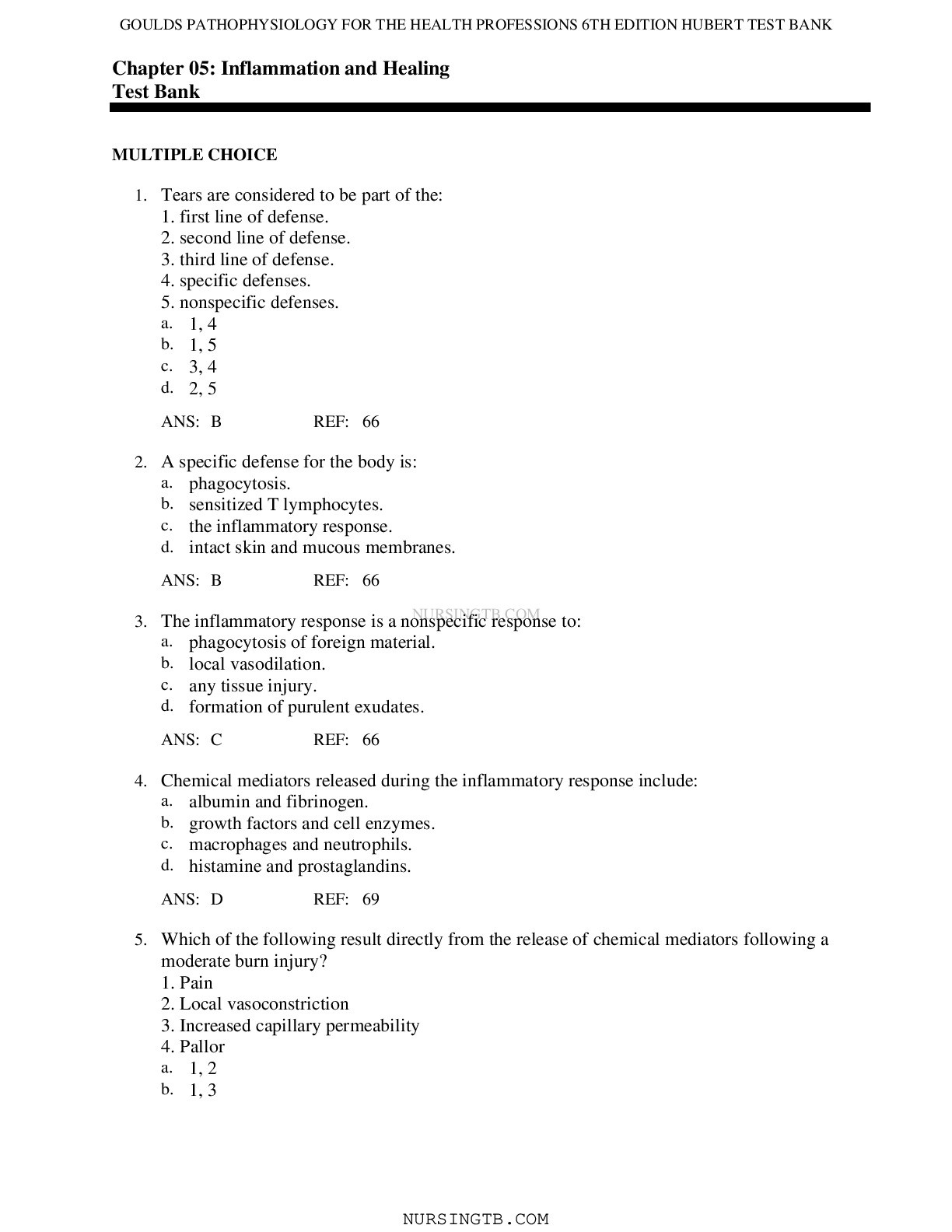1. Tears are considered to be part of the:
1. first line of defense.
2. second line of defense.
3. third line of defense.
4. specific defenses.
5. nonspecific defenses.
a. 1, 4
b. 1, 5
c. 3, 4
d. 2, 5
2. A specific defense for the body is:
a. phagocytosis.
b. sensitized T lymphocytes.
c. the inflammatory response.
d. intact skin and mucous membranes.
3. The inflammatory response
...[Show More]
1. Tears are considered to be part of the:
1. first line of defense.
2. second line of defense.
3. third line of defense.
4. specific defenses.
5. nonspecific defenses.
a. 1, 4
b. 1, 5
c. 3, 4
d. 2, 5
2. A specific defense for the body is:
a. phagocytosis.
b. sensitized T lymphocytes.
c. the inflammatory response.
d. intact skin and mucous membranes.
3. The inflammatory response is a nonspecific response to:
a. phagocytosis of foreign material.
b. local vasodilation.
c. any tissue injury.
d. formation of purulent exudates.
4. Chemical mediators released during the inflammatory response include:
a. albumin and fibrinogen.
b. growth factors and cell enzymes.
c. macrophages and neutrophils.
d. histamine and prostaglandins.
5. Which of the following result directly from the release of chemical mediators following a
moderate burn injury?
1. Pain
2. Local vasoconstriction
3. Increased capillary permeability
4. Pallor
a. 1, 2
b. 1, 3
c. 2, 3
d. 2, 4
6. Granulation tissue is best described as:
a. highly vascular, very fragile, and very susceptible to infection.
b. an erosion through the wall of viscera, leading to complications.
c. a type of adhesion with no vascularization.
d. a form of stenosis, in a duct, that is extremely tough and resists attack by microbes.
7. Edema associated with inflammation results directly from:
a. increased fluid and protein in the interstitial compartment.
b. increased phagocytes in the affected area.
c. decreased capillary permeability.
d. general vasoconstriction.
8. The warmth and redness related to the inflammatory response results from:
a. increased interstitial fluid.
b. production of complement.
c. a large number of white blood cells (WBCs) entering the area.
d. increased blood flow into the area.
9. What is the correct order of the following events in the inflammatory response immediately
after tissue injury?
1. Increased permeability of blood vessels
2. Dilation of blood vessels
3. Transient vasoconstriction
4. Migration of leukocytes to the area
5. Hyperemia
a. 5, 3, 2, 1, 4
b. 1, 2, 4, 5, 3
c. 2, 3, 5, 4, 1
d. 3, 2, 5, 1, 4
10. The process of phagocytosis involves the:
a. ingestion of foreign material and cell debris by leukocytes.
b. shift of fluid and protein out of capillaries.
c. formation of a fibrin mesh around the infected area.
d. movement of erythrocytes through the capillary wall.
11. Systemic effects of severe inflammation include:
[Show Less]
